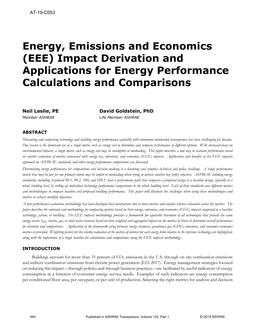
AT-19-C053 — Energy, Emissions and Economics (EEE) Impact Derivation and Applications for Energy Performance Calculations and Comparisons
- Comments Off on AT-19-C053 — Energy, Emissions and Economics (EEE) Impact Derivation and Applications for Energy Performance Calculations and Comparisons
- ASHRAE
Click here to purchase
Measuring and comparing technology and building energy performance equitably with minimum unintended consequences has been challenging for decades. One reason is the dominant use of a single metric such as energy cost to determine and compare performance of different options. With increased focus on environmental impacts, a single metric such as energy cost may be incomplete or misleading. This paper describes a new way to evaluate performance based on relative valuation of metrics associated with energy use, emissions, and economics (EEE) impacts. Application and benefits of the EEE impacts approach in ASHRAE standards and other energy performance comparisons are discussed. Determining energy performance for comparisons and decision making is a daunting and complex technical and policy challenge. A single performance metric that may be fair for one primary intent may be unfair or misleading when trying to achieve another key policy objective. ASHRAE building energy standards, including Standard 90.1, 90.2, 100, and 189.1, have a performance path that compares a proposed design to a baseline design, typically at a whole building level, by rolling up individual technology performance comparisons to the whole building level. Each of these standards uses different metrics and methodologies to compare baseline and proposed building performance. This paper will illustrate the challenges when using these methodologies and metrics to achieve multiple objectives. A new performance evaluation methodology has been developed that incorporates two or more metrics and enables relative valuation across the metrics. The paper describes the rationale and methodology for comparing options based on their energy, emissions, and economics (EEE) impacts compared to a baseline technology, system, or building. The EEE impacts methodology provides a framework for equitable treatment of all technologies that provide the same energy service (e.g., electric, gas, or solar water heaters) based on their weighted and aggregated impact on the metrics of choice to determine overall performance for decisions and comparisons. Application of the framework using primary energy resources, greenhouse gas (GHG) emissions, and consumer economics metrics is provided. Weighting factors for the relative valuation of the metrics of interest for each energy form relative to the reference technology are highlighted, along with the importance of a single baseline for calculations and comparisons using the EEE impacts methodology.
Citation: 2019 Winter Conference, Atlanta, GA, Conference Papers
Product Details
- Published:
- 2019
- Number of Pages:
- 9
- Units of Measure:
- Dual
- File Size:
- 1 file , 1.4 MB
- Product Code(s):
- D-AT-19-C053

